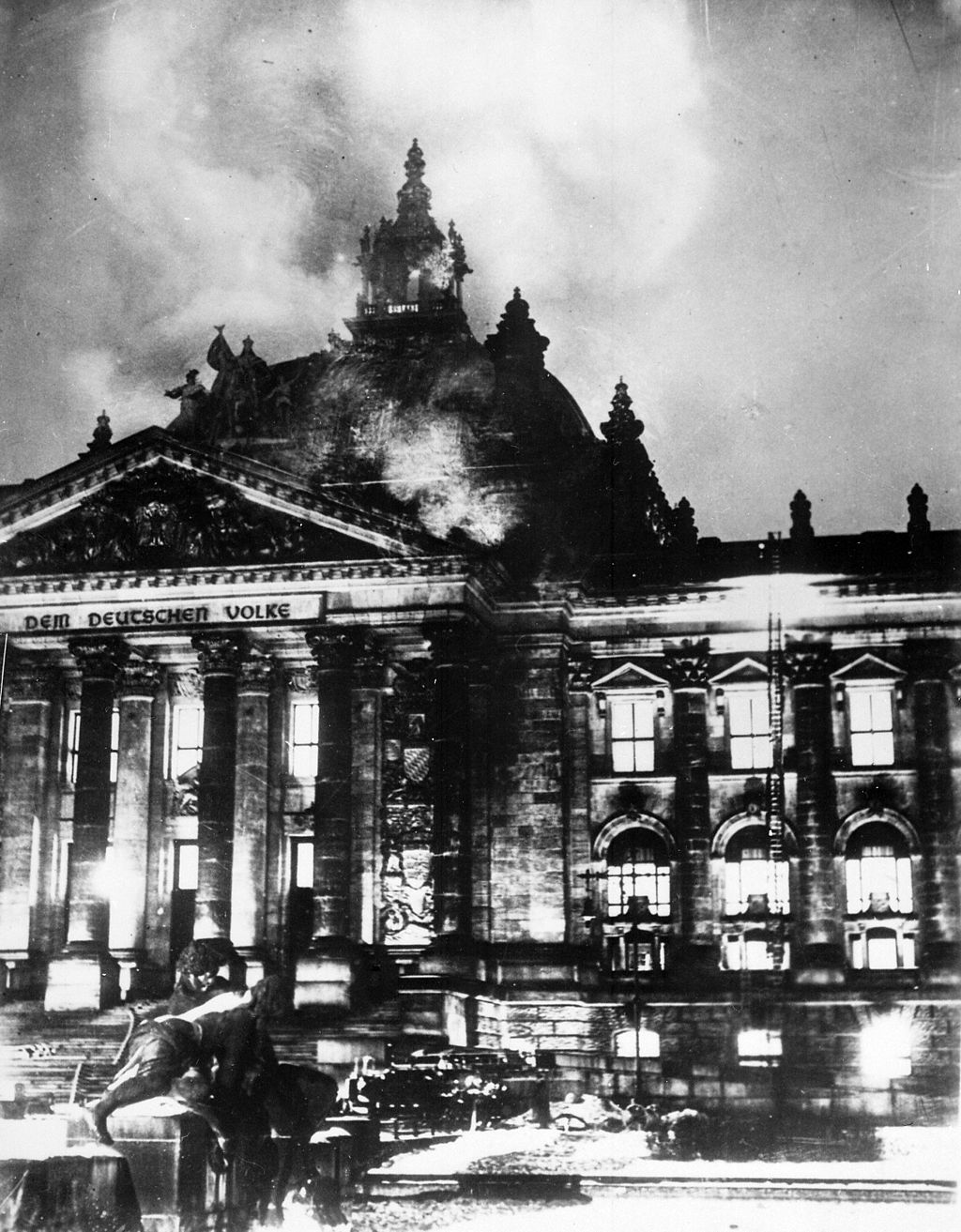Richard J Evans: The Hitler Conspiracies review – Nazi myths debunked | reviews, news & interviews
Richard J Evans: The Hitler Conspiracies review – Nazi myths debunked
Richard J Evans: The Hitler Conspiracies review – Nazi myths debunked
A scrupulous, timely study of the Third Reich's post-truth afterlife

In the days when crowds still thronged airport bookshops, any work entitled The Hitler Conspiracies would surely leap off the shelves. This one ought to flourish in our more immobile times – not least because it unpicks twisted ways of thinking that stretch far beyond the legacy of the Third Reich and its leader.
Setting the biggest lies aside, Evans chooses as his focus a tangles of ideas (mere suppositions in some minds; full-blown articles of faith in others) that you will still find crawling like rampant ivy around any informal discussion of the Nazi period – above all, amid the seething undergrowth of internet chatter. We start off in comparative sanity with the circulation of The Protocols of the Elders of Zion: that notorious “mishmash” of anti-Semitic fantasies, first published in 1903, which pretended to expose a Jewish plot for world domination. Did this cobbled-together fake give Hitler and his crew a “warrant for genocide” and so somehow enable the Holocaust? This chapter comes across as something of an outlier. After all, the Protocols themselves, with their “strange amalgam of bizarre ideas” about an all-powerful Jewish cabal, were (and are) the ultimate conspiracy theory in themselves. To treat this crazed hoax as the secret key to the Nazis’ genocidal ideology becomes conspiracism squared: a historians’ error, rather than the sort of cultish doctrine Evans discusses later. As he proves, Hitler and his elite made little use of the Protocols, regularly exposed as a fraud from the 1920s. Josef Goebbels confided to his diary that he knew they were forged. However, he still believed in their “inner, but not factual” truth. That mantra of the “post-truth” movement recurs through this book.
Next, Evans shows how the Dolchstoss myth took shape: the idea that, in 1918, the German armies of the Great War were not really defeated in battle but “stabbed in the back” by leftists, liberals, Jews and an assortment of other undesirable elements on the home front. Adopted by the vanquished top brass, such as Erich Ludendorff, this notion gave cover to a discredited military hierarchy by shifting the blame for their own failures onto civilian agitators and subversives. Politicians, even on the left, bought into the Dolchstoss to bolster their patriotic credentials. The Social Democrat leader Friedrich Ebert told returning troops that “No enemy has overcome you.” Again, the Nazis “hardly used” stab-in-the-back propaganda themselves. Evans argues that it meant little to “the great majority of the electorate”. It throve nonetheless on the “nationalist right” – where, in other contexts (such as Brexit), you could argue it still does.
 We plunge into deeper tracts of the conspiracist jungle when Evans follows the winding trail of claim and counter-claim that leads from the Reichstag fire of 27 February 1933 (pictured left). The blaze at the German Parliament, four weeks after Hitler’s installation as Chancellor and just before Weimar Germany’s last election, gave the Nazis the licence for dictatorship they needed. Emergency measures shut down democratic institutions and opened the concentration-camp gates. So did the Nazis set the fire? Already, in 1933, Communist activists had begun to spread that suspicion around the world. The Nazis retaliated by inventing evidence of a Red arson plot to destroy parliament. That lie foundered, but a belief in Nazi culpability endures, entrenched by recent books and documentaries. Yet Evans shows, in a meticulous and (to the general reader) rather taxing masterclass in critical historiography, that none of the conspiracy theories remotely stands up to scrutiny. A disturbed Dutch student, Marinus van der Lubbe, raised the fire by himself. What the Nazis then made of this well-timed windfall belongs to history, not myth. But conspiracism, as Evans maintains, cannot accept that a “lone, obscure individual” might trigger world-shaking occurrences. Equally, its Cui bono? mentality insists that “the people who benefit from an event must have caused it”. Hitler profited mightily from the blaze – but even without it, the Nazis “would most likely have found another pretext” for extinguishing German democracy.
We plunge into deeper tracts of the conspiracist jungle when Evans follows the winding trail of claim and counter-claim that leads from the Reichstag fire of 27 February 1933 (pictured left). The blaze at the German Parliament, four weeks after Hitler’s installation as Chancellor and just before Weimar Germany’s last election, gave the Nazis the licence for dictatorship they needed. Emergency measures shut down democratic institutions and opened the concentration-camp gates. So did the Nazis set the fire? Already, in 1933, Communist activists had begun to spread that suspicion around the world. The Nazis retaliated by inventing evidence of a Red arson plot to destroy parliament. That lie foundered, but a belief in Nazi culpability endures, entrenched by recent books and documentaries. Yet Evans shows, in a meticulous and (to the general reader) rather taxing masterclass in critical historiography, that none of the conspiracy theories remotely stands up to scrutiny. A disturbed Dutch student, Marinus van der Lubbe, raised the fire by himself. What the Nazis then made of this well-timed windfall belongs to history, not myth. But conspiracism, as Evans maintains, cannot accept that a “lone, obscure individual” might trigger world-shaking occurrences. Equally, its Cui bono? mentality insists that “the people who benefit from an event must have caused it”. Hitler profited mightily from the blaze – but even without it, the Nazis “would most likely have found another pretext” for extinguishing German democracy.
This maze of imaginary plots takes an almost poignant turn when Evans studies the theory that Hitler, or Churchill, or the pro-German British aristocracy, or perhaps all of them together, masterminded the solo flight to Scotland by Nazi deputy leader Rudolf Hess in May 1941. Sidelined by more aggressive and ambitious paladins of the Third Reich, Hess took his deluded trip in the belief that he could broker a peace deal with Britain. No one on either side had briefed or sent him. At that stage of the war, potential “peace parties” did arguably exist in London and Berlin. However, they had no contact with one another, nor with Hess. Evans warns here against the “guilt by association” reasoning that folds an alignment of interests into “actual collusion”. Hess – a pitiable figure, perhaps, but a vicious anti-Semite all the same – paid dearly for his naivety as the sole prisoner at Spandau jail in Berlin until his suicide, aged 93, in 1987. Of course, the conspiracists believe he was murdered there.
 Until this point, Evans has had to disentangle the knots of fact, speculation, wishful thinking and (sometimes) outright lies found in misguided books, pamphlets, articles and websites that generally maintain a tenuous hold on rationality. His final section, on Adolf Hitler’s alleged escape from his Berlin bunker in 1945, takes us into the very heart of conspiracist darkness. We meet Hitler, often accompanied by Eva Braun and their children, in Argentina. There he lives out a variety of peaceful twilight years, “undefeated and undetected”, seen as a Houdini-like genius and (as the debunking historian Donald McKale writes) “a sort of superman who fooled the world one last time”. One account of the Führer in his Argentinian exile even has him “riding a black ladies’ bicycle from house to house selling herbs”. Oh, and his children include none other than – Angela Merkel.
Until this point, Evans has had to disentangle the knots of fact, speculation, wishful thinking and (sometimes) outright lies found in misguided books, pamphlets, articles and websites that generally maintain a tenuous hold on rationality. His final section, on Adolf Hitler’s alleged escape from his Berlin bunker in 1945, takes us into the very heart of conspiracist darkness. We meet Hitler, often accompanied by Eva Braun and their children, in Argentina. There he lives out a variety of peaceful twilight years, “undefeated and undetected”, seen as a Houdini-like genius and (as the debunking historian Donald McKale writes) “a sort of superman who fooled the world one last time”. One account of the Führer in his Argentinian exile even has him “riding a black ladies’ bicycle from house to house selling herbs”. Oh, and his children include none other than – Angela Merkel.
Much of this hare-brained hogwash would count as comedy gold – were it not for two aspects of the Hitler survival business Evans highlights. First, in the internet age, the Führer-in-Argentina advocates blend into other communities of “alternative knowledge” to create a sort of online Conspiracy International. Their comrades range from anti-Obama “birthers” to old-style anti-Semites and up-to-date zealots on the Trumpian alt-right. No doubt, since Evans completed this work, the Covid denialists have joined the party too. Perhaps more sinister than this intersectional underworld of fantasists and fanatics, big bucks from the entertainment industry have helped to keep the leaky hulk of myths and lies afloat. One of the principal “survivalist” authors “managed to secure $16m. from the History Channel” for a Führer-in-Argentina series. Hunting Hitler ran for three seasons from 2015 to 2018; it has overwhelmingly positive Amazon reviews.
From internet chatrooms to Hollywood boardrooms, the follies and falsehoods Evans dissects not only aim to portray serious historical research as an “official” or “mainstream” smokescreen that keeps what really happened away from the public view. More gravely, they cast cumulative doubt on “the very idea of truth itself” – the playbook of the propagandistic alt-right now, as in the days of their intellectual forerunner Dr Goebbels. For curious consumers, and many of their promoters, conspiracy theories – about the Nazis above all – offer relatively innocent thrills, quests, secrets and heretical Big Reveals. All so different, Evans notes, from “the grey complexity of documented reality”. Many of the old-school obsessives tracked by his research rank as simply sad or, at worst, a little mad. Too many of their cyberspace successors sound conspicuously bad. More than ever, we need the sort of intellectual firewall that this sober, scrupulous work supplies as a defence. That makes The Hitler Conspiracies not just a fairground freakshow but, as Evans writes, “a book for own own troubled times”.
- The Hitler Conspiracies: the Third Reich and the Paranoid Imagination by Richard J Evans (Allen Lane, £20)
- More book reviews on theartsdesk
The future of Arts Journalism
You can stop theartsdesk.com closing!
We urgently need financing to survive. Our fundraising drive has thus far raised £49,000 but we need to reach £100,000 or we will be forced to close. Please contribute here: https://gofund.me/c3f6033d
And if you can forward this information to anyone who might assist, we’d be grateful.

Subscribe to theartsdesk.com
Thank you for continuing to read our work on theartsdesk.com. For unlimited access to every article in its entirety, including our archive of more than 15,000 pieces, we're asking for £5 per month or £40 per year. We feel it's a very good deal, and hope you do too.
To take a subscription now simply click here.
And if you're looking for that extra gift for a friend or family member, why not treat them to a theartsdesk.com gift subscription?
more Books
 'We are bowled over!' Thank you for your messages of love and support
Much-appreciated words of commendation from readers and the cultural community
'We are bowled over!' Thank you for your messages of love and support
Much-appreciated words of commendation from readers and the cultural community
 Elizabeth Alker: Everything We Do is Music review - Prokofiev goes pop
A compelling journey into a surprising musical kinship
Elizabeth Alker: Everything We Do is Music review - Prokofiev goes pop
A compelling journey into a surprising musical kinship
 Natalia Ginzburg: The City and the House review - a dying art
Dick Davis renders this analogue love-letter in polyphonic English
Natalia Ginzburg: The City and the House review - a dying art
Dick Davis renders this analogue love-letter in polyphonic English
 Tom Raworth: Cancer review - truthfulness
A 'lost' book reconfirms Raworth’s legacy as one of the great lyric poets
Tom Raworth: Cancer review - truthfulness
A 'lost' book reconfirms Raworth’s legacy as one of the great lyric poets
 Ian Leslie: John and Paul - A Love Story in Songs review - help!
Ian Leslie loses himself in amateur psychology, and fatally misreads The Beatles
Ian Leslie: John and Paul - A Love Story in Songs review - help!
Ian Leslie loses himself in amateur psychology, and fatally misreads The Beatles
 Samuel Arbesman: The Magic of Code review - the spark ages
A wide-eyed take on our digital world can’t quite dispel the dangers
Samuel Arbesman: The Magic of Code review - the spark ages
A wide-eyed take on our digital world can’t quite dispel the dangers
 Zsuzsanna Gahse: Mountainish review - seeking refuge
Notes on danger and dialogue in the shadow of the Swiss Alps
Zsuzsanna Gahse: Mountainish review - seeking refuge
Notes on danger and dialogue in the shadow of the Swiss Alps
 Patrick McGilligan: Woody Allen - A Travesty of a Mockery of a Sham review - New York stories
Fair-minded Woody Allen biography covers all bases
Patrick McGilligan: Woody Allen - A Travesty of a Mockery of a Sham review - New York stories
Fair-minded Woody Allen biography covers all bases
 Howard Amos: Russia Starts Here review - East meets West, via the Pskov region
A journalist looks beyond borders in this searching account of the Russian mind
Howard Amos: Russia Starts Here review - East meets West, via the Pskov region
A journalist looks beyond borders in this searching account of the Russian mind
 Henry Gee: The Decline and Fall of the Human Empire - Why Our Species is on the Edge of Extinction review - survival instincts
A science writer looks to the stars for a way to dodge our impending doom
Henry Gee: The Decline and Fall of the Human Empire - Why Our Species is on the Edge of Extinction review - survival instincts
A science writer looks to the stars for a way to dodge our impending doom
 Jonathan Buckley: One Boat review - a shore thing
Buckley’s 13th novel is a powerful reflection on intimacy and grief
Jonathan Buckley: One Boat review - a shore thing
Buckley’s 13th novel is a powerful reflection on intimacy and grief
 Help to give theartsdesk a future!
Support our GoFundMe appeal
Help to give theartsdesk a future!
Support our GoFundMe appeal

Add comment